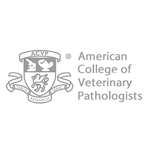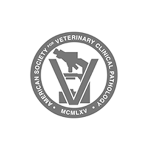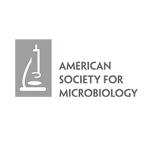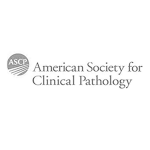Review of Systemic Aspergillosis in Dogs
J.S. Renschler, DVM, PhD, Dipl ACVP
Introduction
Fungi of the genus Aspergillus are ubiquitous in the environment and may occasionally cause opportunistic infections in humans and animals. In dogs, aspergillosis most commonly occurs as a localized sinonasal infection. Disseminated infections (systemic aspergillosis) are less frequently observed and typically involve the intervertebral disks, bones, thoracic lymph nodes, lung and renal pelvis. [11Garcia, R. S., L. J. Wheat, A. K. Cook, E. J. Kirsch, and J. E. Sykes. 2012. Sensitivity and specificity of a blood and urine galactomannan antigen assay for diagnosis of systemic aspergillosis in dogs. J Vet Intern Med 26:911-919.] A bronchopulmonary form of aspergillosis also occurs rarely in dogs. Achieving a definitive diagnosis of any form of aspergillosis can be challenging and/or invasive. Detection of Aspergillus galactomannan antigen in canine urine or serum has recently been demonstrated as a noninvasive, sensitive and specific method for diagnosis of systemic aspergillosis.
Causative Agents
Aspergillus fumigatus, Aspergillus flavus, Aspergillus terreus, Aspergillus niger and Apergillus deflectus have all been shown to cause disease in dogs [2Bruchim, Y., D. Elad, and S. Klainbart. 2006. Disseminated aspergillosis in two dogs in Israel. Mycoses 49:130-133.,8Day, M. J. and W. J. Penhale. 1988. Humoral immunity in disseminated Aspergillus terreus infection in a dog. Vet Microbiol 16:283-294.,9Day, M. J. and W. J. Penhale. 1988. Serum immunoglobulin A concentrations in normal and diseased dogs. Res Vet Sci 45:360-363.,12Kabay, M. J., W. F. Robinson, C. R. Huxtable, and R. McAleer. 1985. The pathology of disseminated Aspergillus terreus infection in dogs. Vet Pathol 22:540-547.,13Kahler, J. S., M. W. Leach, S. Jang, and A. Wong. 1990. Disseminated aspergillosis attributable to Aspergillus deflectus in a Springer Spaniel. J Am Vet Med Assoc 197:871-874.,14Kelly, S. E., S. E. Shaw, and W. T. Clark. 1995. Long-term survival of four dogs with disseminated Aspergillus terreus infection treated with itraconazole. Aust Vet J 72:311- 313.,18Robinson, W. F., M. D. Connole, T. J. King, J. I. Pitt, and S. M. Moss. 2000. Systemic mycosis due to Aspergillus deflectus in a dog. Aust Vet J 78:600- 602.,21Watt, P. R., G. M. Robins, A. M. Galloway, and D. A. OBoyle. 1995. Disseminated opportunistic fungal disease in dogs: 10 cases (1982-1990). J Am Vet Med Assoc 207:67-70.,22Weitkamp, R. A. 1982. Aspergilloma in 2 dogs. J Am Anim Hosp Assoc 18:503-506.]. Sinonasal aspergillosis in dogs is primarily caused by A. fumigatus (and occasionally A. flavus); however, systemic aspergillosis is more frequently attributed to A. terreus and A. deflectus [19Schultz, R. M., E. G. Johnson, E. R. Wisner, N. A. Brown, B. A. Byrne, and J. E. Sykes. 2008. Clinicopathologic and diagnostic imaging characteristics of systemic aspergillosis in 30 dogs. J Vet Intern Med 22:851-859.]. Recent reports describe isolated cases of systemic aspergillosis caused by Aspergillus alabamensis and Aspergillus versicolor [26Zhang, S., W. Corapi, E. Quist, S. Griffin, and M. Zhang. 2012. Aspergillus versicolor, a new causative agent of canine disseminated aspergillosis. J Clin Microbiol 50:187-191.].
Pathogenesis
Aspergillus species are ubiquitous in soil and decaying vegetation. Over 200 species of aspergilli are known, and these organisms produce small hydrophobic conidia (asexual spores) that disperse easily into the air [4Dagenais, T. R. T. and N. P. Keller. 2009. Pathogenesis of Aspergillus fumigatus in invasive aspergillosis. Clin Microbiol Rev 22:447-465.]. Conidia are inhaled and deposited in the bronchioles and alveolar spaces. Due to the abundance of fungal conidia in the environment, the average human may inhale up to 200 A. fumigatus conidia per day [15Latge J.-P. 1999. Aspergillus fumigatus and aspergillosis. Clin Microbiol Rev 12:310-350.]. In healthy individuals, conidia are cleared by mucociliary defenses or phagocytosed by alveolar macrophages. Any remaining germinating conidia are targeted by infiltrating neutrophils that can destroy fungal hyphae. Neutropenic and otherwise immunocompromised patients are at risk for pulmonary colonization leading to tissue injury, uncontrolled fungal growth and potential dissemination by angioinvasion [4Dagenais, T. R. T. and N. P. Keller. 2009. Pathogenesis of Aspergillus fumigatus in invasive aspergillosis. Clin Microbiol Rev 22:447-465.].
Clinical Findings
German shepherd dogs (especially young-middle aged females) are markedly overrepresented in cases of systemic aspergillosis [6Day, M. J. 2006. Aspergillosis and Penicilliosis, p. 613-626. In: C. E. Greene (ed.), 3rd ed. Elsevier, St Louis, Missouri., 10Day, M. J., W. J. Penhale, C. E. Eger, S. E. Shaw, M. J. Kabay, W. F. Robinson, C. R. Huxtable, J. N. Mills, and R. S. Wyburn. 1986. Disseminated aspergillosis in dogs. Aust Vet J 63:55-59.], possibly due to a hereditary IgA deficiency or dysfunction leading to defective mucosal immunity [7Day, M. J., C. E. Eger, S. E. Shaw, and W. J. Penhale. 1985. Immunologic study of systemic aspergillosis in German Shepherd dogs. Vet Immunol Immunopathol 9:335-347.,8Day, M. J. and W. J. Penhale. 1988. Humoral immunity in disseminated Aspergillus terreus infection in a dog. Vet Microbiol 16:283-294.,9Day, M. J. and W. J. Penhale. 1988. Serum immunoglobulin A concentrations in normal and diseased dogs. Res Vet Sci 45:360-363.]. One recent study of 30 dogs with systemic aspergillosis included 20 German shepherd dogs and reported a mean age of 4.5 years and a female: male ratio of 3:1 [19Schultz, R. M., E. G. Johnson, E. R. Wisner, N. A. Brown, B. A. Byrne, and J. E. Sykes. 2008. Clinicopathologic and diagnostic imaging characteristics of systemic aspergillosis in 30 dogs. J Vet Intern Med 22:851-859.]. Clinical signs commonly include limb pain/lameness due to long bone involvement, vertebral pain with possible paraparesis/paraplegia, ataxia, obtundation/mental dullness,visual impairment and other ocular signs related to uveitis, coughing, chronic vomiting, and nonspecific signs (anorexia, weight loss and lethargy) [6Day, M. J. 2006. Aspergillosis and Penicilliosis, p. 613-626. In: C. E. Greene (ed.), 3rd ed. Elsevier, St Louis, Missouri.,19Schultz, R. M., E. G. Johnson, E. R. Wisner, N. A. Brown, B. A. Byrne, and J. E. Sykes. 2008. Clinicopathologic and diagnostic imaging characteristics of systemic aspergillosis in 30 dogs. J Vet Intern Med 22:851-859.] Fungal granulomas frequently develop in the spleen, lymph nodes and kidneys [6Day, M. J. 2006. Aspergillosis and Penicilliosis, p. 613-626. In: C. E. Greene (ed.), 3rd ed. Elsevier, St Louis, Missouri.].
Clinicopathologic Abnormalities
Common abnormalities on the complete blood count include normocytic normochromic anemia, leukocytosis, left shift and neutrophil toxicity. Serum biochemical profile may reveal hyperglobulinemia, azotemia, hypercalcemia and/or hypoalbuminemia. Urinalysis commonly shows isosthenuria, hematuria and pyuria. Fungal hyphae may occasionally be observed in the urine sediment (as well as in aspirates from other affected areas such as lymph nodes, kidneys, pleural effusion, lung, bone, joint fluid, and transtracheal wash). Pyogranulomatous inflammation is also frequently observed in cytologic specimens. In dogs with neurologic signs, CSF often shows neutrophilic pleocytosis [19Schultz, R. M., E. G. Johnson, E. R. Wisner, N. A. Brown, B. A. Byrne, and J. E. Sykes. 2008. Clinicopathologic and diagnostic imaging characteristics of systemic aspergillosis in 30 dogs. J Vet Intern Med 22:851-859.].
Diagnostic Imaging
Radiographic abnormalities commonly include evidence of diskospondylitis, productive and destructive bony changes consistent with osteomyelitis and hilar lymphadenomegaly [11Garcia, R. S., L. J. Wheat, A. K. Cook, E. J. Kirsch, and J. E. Sykes. 2012. Sensitivity and specificity of a blood and urine galactomannan antigen assay for diagnosis of systemic aspergillosis in dogs. J Vet Intern Med 26:911-919., 19Schultz, R. M., E. G. Johnson, E. R. Wisner, N. A. Brown, B. A. Byrne, and J. E. Sykes. 2008. Clinicopathologic and diagnostic imaging characteristics of systemic aspergillosis in 30 dogs. J Vet Intern Med 22:851-859.]. Abdominal ultrasonographic changes are most often detected in the kidneys (e.g., pyelectasia, echogenic debris in a dilated renal pelvis, distinct nodules/masses), spleen, lymph nodes and liver. In dogs with neurologic signs, MRI features may be similar to other inflammatory brain diseases [19Schultz, R. M., E. G. Johnson, E. R. Wisner, N. A. Brown, B. A. Byrne, and J. E. Sykes. 2008. Clinicopathologic and diagnostic imaging characteristics of systemic aspergillosis in 30 dogs. J Vet Intern Med 22:851-859.].
Fungal Culture
Definitive diagnosis of systemic aspergillosis has historically required positive identification of the organism through culture of normally sterile body fluids and tissues. Samples may be acquired from blood, urine, pleural effusion, lymph node aspirates, CSF, bone biopsies, intervertebral disc aspirates, synovial fluid, etc. Although many aspergilli grow rapidly in culture, identification of some species may be a challenging and lengthy process. In addition, sensitivity is low from sites such as urine or blood. One study showed only 52% sensitivity of urine culture in dogs with systemic aspergillosis [19Schultz, R. M., E. G. Johnson, E. R. Wisner, N. A. Brown, B. A. Byrne, and J. E. Sykes. 2008. Clinicopathologic and diagnostic imaging characteristics of systemic aspergillosis in 30 dogs. J Vet Intern Med 22:851-859.]. Collection of culture specimens from other sites (i.e., bone, intervertebral disc) may be more challenging and invasive.
Histology
Histologic evaluation of samples frequently reveals infiltration with fungal hyphae and pyogranulomatous inflammation. Involvement has been observed in a wide variety of tissues, including kidney, spleen, lymph nodes, bone, vertebral endplates, intervertebral disk, liver, heart, pancreas, brain, lungs, eyes, bone marrow, meninges, pleura, small intestine, skin, spinal cord, thyroid, prostate, and trachea/larynx [19Schultz, R. M., E. G. Johnson, E. R. Wisner, N. A. Brown, B. A. Byrne, and J. E. Sykes. 2008. Clinicopathologic and diagnostic imaging characteristics of systemic aspergillosis in 30 dogs. J Vet Intern Med 22:851-859.]. Fungal hyphae appear as 3-8μm wide, septate, hyaline hyphae with parallel walls and acute angle branching [3Burrough, E., K. Deitz, J. Kinyon, C. Andreasen, T. Frana, D. Sutton, E. Thompson, J. Fu, B. Wickes, and J. Hostetter. 2012. Disseminated aspergillosis in a dog due to Aspergillus alabamensis. Medical Mycology Case Reports 1:1-4.,16McClenny, N. 2005. Laboratory detection and identification of Aspergillus species by microscopic observation and culture; the traditional approach. Medical Mycology Supplement I 43:S125-S128.]
Antibody Detection
In dogs with nasal aspergillosis, detection of serum anti Aspergillus antibodies (by either agar gel immunodiffusion or enzyme-linked immunoassay [EIA]) has moderate sensitivity and high specificity.(1Billen, F., D. Peeters, I. R. Peters, C. R. Helps, P. Huynen, P. De Mol, L. Massart, M. J. Day, and C. Clercx. 2009.Comparison of the value of measurement of serum galactomannan and Aspergillus-specific antibodies in the diagnosis of canine sino-nasal aspergillosis.Vet Microbiol 133:358-365.) In contrast, current antibody tests appear to have little clinical utility in the diagnosis of systemic aspergillosis. Sensitivity was only 20% in a small sample of 5 dogs [19Schultz, R. M., E. G. Johnson, E. R. Wisner, N. A. Brown, B. A. Byrne, and J. E. Sykes. 2008. Clinicopathologic and diagnostic imaging characteristics of systemic aspergillosis in 30 dogs. J Vet Intern Med 22:851-859.]. Galactomannan Antigen Detection The PlateliaTM Aspergillus antigen assay (Bio-Rad Laboratories; Redman, WA) is an EIA for the detection of Aspergillus galactomannan antigen in body fluids. In humans, the assay is useful in the diagnosis of systemic aspergillosis which most often occurs in immunosuppressed patients (e.g., neutropenia, solid organ transplant, bone marrow transplant).
Sensitivity and specificity vary based on underlying condition and cutoff for positivity (galactomannan index; GMI). A metaanalysis of human studies showed an overall sensitivity of 71% and specificity of 89% [17Pfeiffer, C. D., J. P. Fine, and N. Safdar. 2006. Diagnosis of invasive aspergillosis using a galactomannan assay: A meta-analysis. Clin Infect Dis 42:1417-1427.]. A GMI ≥ 0.5 is considered to be positive for galactomannan antigen, as recommended by the assay manufacturer. In a 2012 study of dogs with systemic aspergillosis (using cutoff GMI ≥ 0.5), the sensitivity was 92% in serum and 88% in urine, while the specificity was 84% in serum and 92% in urine [11Garcia, R. S., L. J. Wheat, A. K. Cook, E. J. Kirsch, and J. E. Sykes. 2012. Sensitivity and specificity of a blood and urine galactomannan antigen assay for diagnosis of systemic aspergillosis in dogs. J Vet Intern Med 26:911-919.].
Any false negatives in this study were cases of localized pulmonary aspergillosis; therefore, the assay sensitivity was 100% (in either serum or urine) for disseminated disease. False positives could be decreased slightly by using a higher cutoff value (GMI ≥ 1.5) without affecting the sensitivity in urine. False positives may be attributed to other fungal infections with crossreactive galactomannan (i.e., disseminated penicilliosis, paecilomycosis, geotrichosis, etc.) or administration of Penicillium-derived antibiotics (amoxicillin-clavulanate and other beta lactam antibiotics) or Plasma-Lyte® (Baxter, Deerfield, IL) or other gluconate-containing fluids [11Garcia, R. S., L. J. Wheat, A. K. Cook, E. J. Kirsch, and J. E. Sykes. 2012. Sensitivity and specificity of a blood and urine galactomannan antigen assay for diagnosis of systemic aspergillosis in dogs. J Vet Intern Med 26:911-919.,25Wheat, L. J. and T. J. Walsh. 2008. Diagnosis of invasive aspergillosis by galactomannan antigenemia detection using an enzyme immunoassay. Eur J Clin Microbiol Infect Dis 27:245-251.].
In humans, false positivity has occasionally been reported in cases of cryptococcosis [5Dalle, F., P. E. Charles, K. Blanc, D. Caillot, P. Chavanet, F. Dromer, and A. Bonnin. 2005. Cryptococcus neoformans galactoxylomannan contains an epitope(s) that is cross-reactive with Aspergillus galactomannan. J Clin Microbiol 43:2929-2931.] and blastomycosis [20Van der Veer, J., R. J. Lewis, A. M. Emtiazjoo, S. D. Allen, L. J. Wheat, and C. A. Hage. 2012. Cross reactivity in the Platelia Aspergillus enzyme immunoassay caused by blastomycosis. Med Mycol 50:396-398.], as well as approximately half of cases of histoplasmosis [24Wheat, L. J., E. Hackett, M. Durkin, P. Connolly, R. Petraitiene, T. J. Walsh, K. Knox, and C. Hage. 2007. Histoplasmosis-associated cross reactivity in the Bio-Rad Platelia Aspergillus enzyme immunoassay. Clin Vaccine Immunol 14:638-640.]. In contrast with the pattern described in human patients, all dogs with systemic aspergillosis in this study had profound increases in GMI in both serum (>5.0) and urine (>4.0). Additional studies are necessary to determine the optimum specimen type for the assay; however, at this time, both serum and urine appear to be acceptable for diagnosis [11Garcia, R. S., L. J. Wheat, A. K. Cook, E. J. Kirsch, and J. E. Sykes. 2012. Sensitivity and specificity of a blood and urine galactomannan antigen assay for diagnosis of systemic aspergillosis in dogs. J Vet Intern Med 26:911-919.]. Aspergillus galactomannan may also be detected in bronchoalveolar lavage fluid and CSF [23Wheat, L. J. 2009. Approach to the diagnosis of invasive aspergillosis and candidiasis. Clin Chest Med 30:367-377.].
Treatment
Prognosis is often poor in cases of systemic aspergillosis, and many dogs are euthanized due to severe CNS signs, pain or respiratory distress. Antifungal therapy agents such as itraconazole, amphotericin B and/or terbinafine should be considered in dogs with less severe signs.
In one study, survival times of treated dogs had a wide range with one dog surviving 25 months after diagnosis [19Schultz, R. M., E. G. Johnson, E. R. Wisner, N. A. Brown, B. A. Byrne, and J. E. Sykes. 2008. Clinicopathologic and diagnostic imaging characteristics of systemic aspergillosis in 30 dogs. J Vet Intern Med 22:851-859.]. This dog had received lipid complex amphotericin B, newer azole derivatives and echinocandins. Another report described survival >3 years in a dog treated only with itraconazole [14Kelly, S. E., S. E. Shaw, and W. T. Clark. 1995. Long-term survival of four dogs with disseminated Aspergillus terreus infection treated with itraconazole. Aust Vet J 72:311- 313.]. Antifungal resistance by Aspergillus has emerged as a problem, and therefore newer azole drugs such as voriconazole, posaconazole, ravuconazole and isavuconazole have been utilized to treat invasive aspergillosis in humans. The newer azoles have had limited use in veterinary medicine due to high cost; however, voriconazole now is available in generic form. One recent case report described successful treatment of aspergillosis in a bottlenose dolphin with high dose posaconazole [27Bunskoek, P.E., S. Seyedmousavi, S. Gans, P. van Vierzen, W. Melchers, C. van Elk, J. Mouton and P. Verweij. 2017. Successful treatment of azole-resistant invasive aspergillosis in a bottlenose dolphin with high-dose posaconazole. Med Mycol Case Reports 16:16-19].
Conclusion
Systemic aspergillosis is an uncommon condition observed primarily in young-middle aged female German shepherd dogs (and occasionally other breeds). Fungal colonization initially occurs in the lungs, followed by dissemination to numerous other body sites. Common clinical signs are attributed to disease in the musculoskeletal, neurologic, respiratory and GI systems. Diagnosis by identification of organisms through histology and/or culture can be challenging or invasive. The galactomannan antigen test is a noninvasive, sensitive and specific assay to aid in the diagnosis of disseminated Aspergillus infection in dogs. Although prognosis is poor, treatment should be considered in dogs with less severe clinical signs.
REFERENCES:
- Billen, F., D. Peeters, I. R. Peters, C. R. Helps, P. Huynen, P. De Mol, L. Massart, M. J. Day, and C. Clercx. 2009.
Comparison of the value of measurement of serum galactomannan and Aspergillus-specific antibodies in the diagnosis of canine sino-nasal aspergillosis.
Vet Microbiol 133:358-365.
- Bruchim, Y., D. Elad, and S. Klainbart. 2006. Disseminated aspergillosis in two dogs in Israel. Mycoses 49:130-133.
- Burrough, E., K. Deitz, J. Kinyon, C. Andreasen, T. Frana, D. Sutton, E. Thompson, J. Fu, B. Wickes, and J. Hostetter. 2012. Disseminated aspergillosis in a dog due to Aspergillus alabamensis. Medical Mycology Case Reports 1:1-4.
- Dagenais, T. R. T. and N. P. Keller. 2009. Pathogenesis of Aspergillus fumigatus in invasive aspergillosis. Clin Microbiol Rev 22:447-465.
- Dalle, F., P. E. Charles, K. Blanc, D. Caillot, P. Chavanet, F. Dromer, and A. Bonnin. 2005. Cryptococcus neoformans galactoxylomannan contains an epitope(s) that is cross-reactive with Aspergillus galactomannan. J Clin Microbiol 43:2929-2931.
- Day, M. J. 2006. Aspergillosis and Penicilliosis, p. 613-626. In: C. E. Greene (ed.), 3rd ed. Elsevier, St Louis, Missouri.
- Day, M. J., C. E. Eger, S. E. Shaw, and W. J. Penhale. 1985. Immunologic study of systemic aspergillosis in German Shepherd dogs. Vet Immunol Immunopathol 9:335-347.
- Day, M. J. and W. J. Penhale. 1988. Humoral immunity in disseminated Aspergillus terreus infection in a dog. Vet Microbiol 16:283-294.
- Day, M. J. and W. J. Penhale. 1988. Serum immunoglobulin A concentrations in normal and diseased dogs. Res Vet Sci 45:360-363.
- Day, M. J., W. J. Penhale, C. E. Eger, S. E. Shaw, M. J. Kabay, W. F. Robinson, C. R. Huxtable, J. N. Mills, and R. S. Wyburn. 1986. Disseminated aspergillosis in dogs. Aust Vet J 63:55-59.
- Garcia, R. S., L. J. Wheat, A. K. Cook, E. J. Kirsch, and J. E. Sykes. 2012. Sensitivity and specificity of a blood and urine galactomannan antigen assay for diagnosis of systemic aspergillosis in dogs. J Vet Intern Med 26:911-919.
- Kabay, M. J., W. F. Robinson, C. R. Huxtable, and R. McAleer. 1985. The pathology of disseminated Aspergillus terreus infection in dogs. Vet Pathol 22:540-547.
- Kahler, J. S., M. W. Leach, S. Jang, and A. Wong. 1990. Disseminated aspergillosis attributable to Aspergillus deflectus in a Springer Spaniel. J Am Vet Med Assoc 197:871-874.
- Kelly, S. E., S. E. Shaw, and W. T. Clark. 1995. Long-term survival of four dogs with disseminated Aspergillus terreus infection treated with itraconazole. Aust Vet J 72:311- 313.
- Latge J.-P. 1999. Aspergillus fumigatus and aspergillosis. Clin Microbiol Rev 12:310-350.
- McClenny, N. 2005. Laboratory detection and identification of Aspergillus species by microscopic observation and culture; the traditional approach. Medical Mycology Supplement I 43:S125-S128.
- Pfeiffer, C. D., J. P. Fine, and N. Safdar. 2006. Diagnosis of invasive aspergillosis using a galactomannan assay: A meta-analysis. Clin Infect Dis 42:1417-1427.
- Robinson, W. F., M. D. Connole, T. J. King, J. I. Pitt, and S. M. Moss. 2000. Systemic mycosis due to Aspergillus deflectus in a dog. Aust Vet J 78:600- 602.
- Schultz, R. M., E. G. Johnson, E. R. Wisner, N. A. Brown, B. A. Byrne, and J. E. Sykes. 2008. Clinicopathologic and diagnostic imaging characteristics of systemic aspergillosis in 30 dogs. J Vet Intern Med 22:851-859.
- Van der Veer, J., R. J. Lewis, A. M. Emtiazjoo, S. D. Allen, L. J. Wheat, and C. A. Hage. 2012. Cross reactivity in the Platelia Aspergillus enzyme immunoassay caused by blastomycosis. Med Mycol 50:396-398.
- Watt, P. R., G. M. Robins, A. M. Galloway, and D. A. OBoyle. 1995. Disseminated opportunistic fungal disease in dogs: 10 cases (1982-1990). J Am Vet Med Assoc 207:67-70.
- Weitkamp, R. A. 1982. Aspergilloma in 2 dogs. J Am Anim Hosp Assoc 18:503-506.
- Wheat, L. J. 2009. Approach to the diagnosis of invasive aspergillosis and candidiasis. Clin Chest Med 30:367-377.
- Wheat, L. J., E. Hackett, M. Durkin, P. Connolly, R. Petraitiene, T. J. Walsh, K. Knox, and C. Hage. 2007. Histoplasmosis-associated cross reactivity in the Bio-Rad Platelia Aspergillus enzyme immunoassay. Clin Vaccine Immunol 14:638-640.
- Wheat, L. J. and T. J. Walsh. 2008. Diagnosis of invasive aspergillosis by galactomannan antigenemia detection using an enzyme immunoassay. Eur J Clin Microbiol Infect Dis 27:245-251.
- Zhang, S., W. Corapi, E. Quist, S. Griffin, and M. Zhang. 2012. Aspergillus versicolor, a new causative agent of canine disseminated aspergillosis. J Clin Microbiol 50:187-191.
- Bunskoek, P.E., S. Seyedmousavi, S. Gans, P. van Vierzen, W. Melchers, C. van Elk, J. Mouton and P. Verweij. 2017. Successful treatment of azole-resistant invasive aspergillosis in a bottlenose dolphin with high-dose posaconazole. Med Mycol Case Reports 16:16-19








